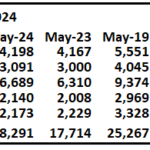
PM Images
The Nuveen Preferred & Income Term Fund (NYSE:JPI) is a closed-end fund, or CEF, that can be employed by income-focused investors who are seeking to maximize the income that they receive from their portfolios. As the name of the fund suggests, the Nuveen Preferred & Income Term Fund seeks to accomplish this task by investing primarily in fixed-income securities, which unfortunately means that its ability to protect against inflation is relatively limited. After all, as I have pointed out in numerous previous articles (such as this one), fixed-income securities do not appreciate in price due to inflation because they have no connection to the net income or cash flow growth of the issuing company.
There are numerous reasons to expect that inflation will be a continual problem in the United States going forward, which is the reason why gold prices keep going up every time the market starts to think that the Federal Reserve will cut interest rates. After all, the data right now says that if the central bank genuinely wants to stop inflation, then it needs to start hiking interest rates and shock the market. In short, the Nuveen Preferred & Income Fund can provide us with a reasonable level of income, but it is not necessarily going to protect the purchasing power of our money over time.
The fund’s current yield is also a bit low for a preferred stock fund. As of the time of writing, the Nuveen Preferred & Income Term Fund has a 6.09% distribution yield. As we can see here, this is a bit lower than its peers possess:
Fund Name | Morningstar Classification | Current Yield |
Nuveen Preferred & Income Term Fund | Fixed Income-Taxable-Preferreds | 6.09% |
Cohen & Steers Select Preferred and Income Fund (PSF) | Fixed Income-Taxable-Preferreds | 7.69% |
First Trust Intermediate Duration Preferred & Income Fund (FPF) | Fixed Income-Taxable-Preferreds | 9.30% |
Flaherty & Crumrine Preferred Securities Fund (FFC) | Fixed Income-Taxable-Preferreds | 7.16% |
John Hancock Preferred Income Fund (HPI) | Fixed Income-Taxable-Preferreds | 8.78% |
As we can immediately see, the Nuveen Preferred & Income Term Fund has a significantly lower yield than any of its peer funds. This is something that will almost certainly be a turn-off for any investor who is considering investing in a preferred stock fund. After all, the primary reason why anyone purchases preferred stock is because of the high yield that is paid by these securities. As the yield of this fund is much lower than that of its peers, it is moderately less appealing to those who desire income.
As regular readers can likely remember, we previously discussed the Nuveen Preferred & Income Term Fund in the middle of October 2023. The market has generally been strong since that date, as various market participants have become committed to the expectation that the Federal Reserve will lower interest rates in the near future. While the market’s conviction on this front has been sliding, causing bond prices to fall year-to-date, preferred stock has stubbornly held its ground.
As such, we might expect that the Nuveen Preferred & Income Term Fund has delivered a strong performance since the date of our previous discussion. This is indeed the case, as shares of the Nuveen Preferred & Income Term Fund have appreciated by 16.53% since the date that the previous article was published:

Seeking Alpha
As we can clearly see, the fund’s shares have significantly outperformed the ICE Exchange-Listed Preferred & Hybrid Securities Index (PFF). I also included both the Bloomberg U.S. Aggregate Bond Index (AGG) and the Bloomberg High Yield Very Liquid Index (JNK) for comparison purposes, but both of those indices focus on a different asset class (bonds versus preferred stock). Nonetheless, bonds are frequently considered to be an alternative to preferred stock for income investors, and we can clearly see that the Nuveen Preferred & Income Term Fund managed to outperform both of them by quite a lot.
Investors in this fund have actually done better over the eight-month period than the chart above shows. As I explained in a previous article:
A simple look at a closed-end fund’s price performance does not necessarily provide an accurate picture of how investors in the fund did during a given period. This is because these funds tend to pay out all of their net investment profits to the shareholders, rather than relying on the capital appreciation of their share price to provide a return. This is the reason why the yields of these funds tend to be much higher than the yield of index funds or most other market assets.
To see how investors in this fund truly did since the previous article was published in mid-October 2023, we need to include the distributions that were paid out by the Nuveen Preferred & Income Term Fund as well as by each of the indices shown above. When we do that, we get this alternative chart:

Seeking Alpha
We can immediately see that the Nuveen Preferred & Income Term Fund still outperformed all three of the indices. However, the difference is not quite as stark regarding the preferred stock and junk bond indices. This is because the junk bond index actually has a higher yield than this fund does. The preferred stock index has a trailing twelve-month yield of 6.47%, so it too has a higher yield than this fund. Thus, both of these indices ended up getting a greater total return boost due to their distributions than the Nuveen Preferred & Income Term Fund. The fact that this fund has a lower yield than two of the three major domestic fixed-income indices also removes one of the reasons for investing in a leveraged closed-end fund as opposed to a fixed-income index.
As eight months have passed since the date of our previous discussion, there have been several changes with both the fund and the market as a whole. In particular, the fund has released an updated financial report that we will want to review to determine how sustainable the fund and its distribution are likely to be. Therefore, let us take a look at this fund and see if it still makes sense to own it.
About The Fund
According to the fund’s website, the Nuveen Preferred & Income Term Fund has the primary objective of providing its investors with a high level of current income and total return. The current income objective makes a lot of sense when we consider the fund’s strategy, although the total return objective seems a bit redundant. The website explains the strategy in detail:
The Fund seeks to provide a high level of current income and total return by investing at least 80% of its managed assets in preferred and other income-producing securities, including hybrid securities such as contingent capital securities, with a focus on securities issued by financial and insurance firms. At least 50% of its managed assets are rated investment grade at the time of purchase or, if unrated, judged to be of comparable quality by the fund’s portfolio team.
The Fund uses leverage and has a 12-year term and intends to liquidate and distribute its then-current assets to shareholders on or before 31 Aug 2024.
This quote directly says that the fund invests its assets primarily in preferred stock or contingent capital securities. As I explained in a recent article, a contingent capital security is basically a preferred stock issued by a European bank that has a “buy-in” clause if the bank’s capital falls below a specified level. Basically, the investors in these securities suffer some losses in certain situations rather than the bank needing a governmental bailout. Most of Nuveen’s preferred stock funds also hold these securities to one degree or another.
The fund seems to comply with its stated mandate of having 80% of its managed assets invested in preferred securities. The Q3 2024 Holdings Report states that the fund’s assets as of April 30, 2024, consisted of:
Asset Type | % of Total Assets |
$1,000 Par Institutional Preferred Stock | 50.8% |
Contingent Capital Securities | 28.4% |
$25 Par Retail Preferred Stock | 19.4% |
Corporate Bonds | 0.2% |
Repurchase Agreements | 1.2% |
If we consider contingent capital securities to be preferred stock, which they basically are, then the fund has 98.6% of its total assets invested in these securities. If we wish to exclude the contingent capital securities from the preferred stock total, we arrive at 70.2% of total assets. The fund therefore appears to be fulfilling its mandate of investing at least 80% of its assets in preferred stock or similar securities.
This is what makes the fund’s total return objective rather redundant, as preferred stock delivers nearly all of its total return in the form of direct payments to its holders. While it is possible to make some trading profits by exploiting the fact that preferred stock prices tend to move inversely to interest rates, these securities derive no benefit from the growth of the underlying company, so they do not deliver long-term capital gains. Thus, the total return objective is redundant alongside the current income objective.
In the previous article on this fund, we saw that the Nuveen Preferred & Income Term Fund is heavily invested in banks. This should not be surprising, as the strategy description on the fund’s own website explicitly states that the fund focuses its attention on investing in securities issued by financial institutions and insurance companies. As of April 30, 2024, the fund had 44.3% of its assets invested in diversified banks and 13.1% of its assets invested in insurance companies:

Nuveen Investments
We also see a 12.4% weighting to capital markets companies and an 8.9% weighting to regional banks. This gives the fund a total weighting of 53.9% to banks and 78.7% total weighting to all financial institutions and insurance companies. That seems to fit well with the fund’s statements of having a primary focus on investing in financial institutions and insurance companies, although it does fall a bit short of 80%. The fund’s objectives and strategy description on the website does not explicitly require that the fund have a set percentage of its assets invested in the financial industry, however.
It should not be surprising that an outsized percentage of the fund’s assets are invested in banks. After all, as I explained in a recent article on another preferred stock fund:
Banks and utilities are the largest issuers of preferred stock in the market. As a result, almost any preferred stock fund will be very heavily weighted towards these two types of companies. With that said though, usually the overwhelming majority of companies in the top ten list are banks. This is due to international banking regulations that require banks to hold a certain percentage of their assets in the form of Tier one capital. Tier One capital refers to that proportion of a bank’s assets that are not simultaneously a liability to somebody else (such as a depositor). When regulators require that a bank increase its Tier One capital, its only options are to issue either common or preferred stock. The bank will often choose to issue preferred stock in order to avoid diluting the common stockholders.
Companies in other industries do not have to follow strict regulations regarding their capital structure as banks do, so they have historically preferred to issue debt because debt is cheaper than preferred stock. Thus, banks are the largest issuers of preferred stock in the market, and pretty much every preferred stock fund will have outsized exposure to these companies. We can see this in the structure of the ICE Exchange-Listed Preferred & Hybrid Securities Index as well. BlackRock states that the index fund tracking that index has the following sector weightings:

BlackRock
Thus, we can see that the Nuveen Preferred & Income Term Fund is slightly overweight to the financial sector relative to the index, but it is not a substantial overweight. The real difference comes from the fact that the Nuveen Preferred & Income Term Fund invests in both domestic and foreign assets, whereas the index is American assets only.
In fact, the Nuveen Preferred & Income Term Fund is fairly well-balanced between domestic and foreign securities:

Nuveen Investments
This is a bit surprising, as many global funds have a much higher weighting to the United States. However, the Nuveen Preferred & Income Term Fund is still substantially overweight to the United States compared to the actual size of the market. According to J.P. Morgan Asset Management, only 33.05% of the preferred stock issued globally is issued by American entities:

JP Morgan Asset Management
We can see that European institutions actually issue more preferred stock than American institutions do. Thus, if the fund wanted to more accurately reflect the global preferred stock market, European entities should have a higher weighting than domestic ones. However, this fund still needs to appeal to American investors, and many American investors seem to prefer investing in American entities instead of foreign ones. Based on the fund’s current weightings, the fund is probably more helpful than some other ones at reducing an American investor’s domestic exposure, but it is hardly perfect in this respect. We should probably try to find some funds that are ex-U.S. to achieve proper international exposure.
One thing that sets the Nuveen Preferred & Income Term Fund apart from other preferred closed-end funds is that it has very limited utility exposure. The third-quarter 2024 holdings report only lists 2.6% of net assets invested in multi-utility companies, 2.9% of net assets invested in electric utilities, and another 1.4% of net assets invested in independent power generation companies. That is a negligible percentage overall. It is much smaller than the Food Service category, which accounts for 4.2% of the fund’s total assets.
These positions consist almost entirely of preferred stocks issued by three entities: Land O’ Lakes, Dairy Farmers of America, and CHS. All three of these entities are cooperative associations, so their common equity is owned by their members, and they do not trade on any exchange. They have issued some preferred stock over the years as a way to raise money, though, some of which is included in this fund. It is not common to see these securities in any other preferred stock closed-end fund except for the ones that are managed by Nuveen, so this fund could offer a way for investors to gain access to an industry that is difficult to invest in by other means.
With that said, though, these securities still only account for a tiny percentage of the fund’s assets, so it is far from a direct investment. The CHS preferred stock exposure can easily be obtained by purchasing it directly (CHSCP, CHSCL), so if your reason for buying or investing in this fund is at all related to the presence of this asset class then it would be best just to purchase the preferred stock directly.
Leverage
As is the case with most closed-end funds, the Nuveen Preferred & Income Term Fund employs leverage as a method of boosting the effective yield that it earns from the securities in its portfolio. I explained how this works in my previous article on this fund:
In short, the fund borrows money and then uses this borrowed money to purchase preferred stock or other income-producing assets. As long as the purchased assets have a higher yield than the interest rate that the fund has to pay on the borrowed money, the strategy works pretty well to boost the effective yield of the portfolio. As this fund is capable of borrowing money at institutional rates, which are considerably lower than retail rates, this will usually be the case. However, it is important to note that this strategy is not as effective today as it was three years ago when the borrowing rate was essentially 0%. This is because the difference between the interest rate that the fund has to pay on the borrowed money and the yield that it receives from the purchased assets is less than it once was.
However, the use of debt in this fashion is a double-edged sword. This is because leverage boosts both gains and losses. Thus, the fund will decline much more during a market correction than it would if it were unleveraged. As such, we want to ensure that the fund is not employing too much leverage because that would expose us to an excessive amount of risk. I generally do not like a fund’s leverage to exceed a third as a percentage of its assets for this reason.
As of the time of writing, the Nuveen Preferred & Income Term Fund has leveraged assets comprising 36.34% of its portfolio. This is significantly less than the 38.00% leverage ratio that the fund had the last time that we discussed it, which is not really surprising. After all, the fund’s net asset value is up 12.71% since the date that the previous article was published:

Barchart
Thus, the fund’s portfolio is now larger than it was previously. If its outstanding borrowings remained the same, they now represent a smaller proportion of a larger portfolio. This is the same dynamic that we have seen with numerous other preferred stock funds over the period in question, as the rally that has pushed up the price of these securities since early November has also reduced the leverage of most funds.
However, we can see that the leverage ratio of the Nuveen Preferred & Income Term Fund is still above the one-third of assets levels that we would ordinarily prefer, despite the decline over the past eight months. As such, it may be exposing us to too much risk. Let us compare this fund’s leverage ratio with that of its peers to see if it is using too much for its strategy:
Fund Name | Leverage Ratio |
Nuveen Preferred & Income Term Fund | 36.34% |
Cohen & Steers Select Preferred and Income Fund | 33.60% |
First Trust Intermediate Duration Preferred & Income Fund | 33.61% |
Flaherty & Crumrine Preferred Securities Fund | 39.50% |
John Hancock Preferred Income Fund | 37.98% |
(all figures from CEF Data.)
As we can immediately see, the leverage ratio of the Nuveen Preferred & Income Term Fund is the median of its peer group. This is a positive sign as it suggests that the fund is not employing an excessive level of leverage for its particular strategy. Overall, investors should not need to lose too much sleep at night over this fund’s debt.
Distribution Analysis
The primary objectives of the Nuveen Preferred & Income Term Fund are to provide its investors with a very high level of current income and total return. To this end, the fund pays a monthly distribution of $0.0980 per share ($1.176 per share annually). This gives the fund a 6.09% yield at the current share price. As we saw earlier, this is a fairly low yield compared to what some of the fund’s peers are currently offering.
The Nuveen Preferred & Income Term Fund has not been particularly consistent regarding its distribution over the years:

CEF Connect
As I stated in the previous article:
As such, this fund may not be appealing to anyone who is seeking a stable and secure source of income to pay their bills or finance their lifestyles. Indeed, the fact that it has a liquidation date of August 31, 2024, further reduces its appeal to those investors since they would need to find a new place to put their money after liquidation. However, the fund will continue to pay a distribution to its shareholders until its liquidation date, so we do want to examine how well it can accomplish that based on its current financial performance. After all, the situation that we want is for it to sustain a stable payout until it liquidates.
As of the time of writing, the fund’s most recent financial report is the semi-annual report that corresponds to the six-month period that ended on January 31, 2024. This is obviously a much newer report than the one that we had available to us the last time that we discussed this fund, so it should work pretty well as an update.
For the six-month period, the Nuveen Preferred & Income Term Fund received $4,788,073 in dividends along with $17,872,399 in interest from the investments in its portfolio. When we combine this with a small amount of income from other sources, we arrive at a total investment income of $22,690,859 for the period. The fund paid its expenses out of this amount, which left it with $11,802,765 available for shareholders. That was not sufficient to fully cover the $13,390,182 that the fund paid out in distributions over the period.
The fund was, fortunately, able to make up the difference through capital gains. For the six-month period, it reported net realized losses of $2,122,934 but more than offset this with $25,731,007 net unrealized gains. Overall, the fund’s net asset value increased by $22,020,656 after accounting for all gains and losses during the period.
The Nuveen Preferred & Income Term Fund thus managed to cover its distribution, but only because of unrealized capital gains. Unrealized capital gains can be easily erased, but this is not necessarily a problem for a term fund that is getting close to its liquidation date. After all, the fund is currently scheduled to distribute whatever assets it has left to its shareholders at the end of August. Thus, if the fund’s assets give up some of the unrealized gains between now and that date, it is essentially just an early partial liquidation. A dollar today is always more valuable than a dollar in the future, so reliance on unrealized capital gains to cover distributions seems acceptable at this point.
Valuation
Shares of the Nuveen Preferred & Income Term Fund are currently trading at a 2.38% discount to net asset value. This is less than the 3.35% discount that the shares have had on average over the past month, so the current price looks a bit expensive.
All else being equal, though, if an investor buys these shares discounted, then it could represent an opportunity. The fund will pay out its net asset value at dissolution at the end of August, so if its net asset value remains relatively stable, then buying discounted will provide an easy gain in a few months. The fund is currently trying to change into a perpetual fund, but even in that scenario, it will offer investors a choice between receiving net asset value or continuing with the fund. Thus, there could be an opportunity to earn a short-term gain here, assuming that the market does not collapse in the next six weeks or so.
Conclusion
In conclusion, the Nuveen Preferred & Income Term Fund looks like a pretty decent fund for what it is. There is more foreign exposure here than I expected to find, but the fund is still overweight to the United States. That is hardly a complaint about this fund exclusively, though, since there are very few preferred stock funds that are only going to have a 33.05% weighting to the United States that properly reflects its representation in the global market. The fund had to rely on unrealized capital gains to cover its distributions in the most recent half-year period, but that is not the end of the world for a term fund that expires in a few months. The biggest thing about Nuveen Preferred & Income Term Fund is that it is uncertain whether investors today will be allowed to stay in the fund after the end of August, so it might only be a short-term investment for someone who purchases it today.








